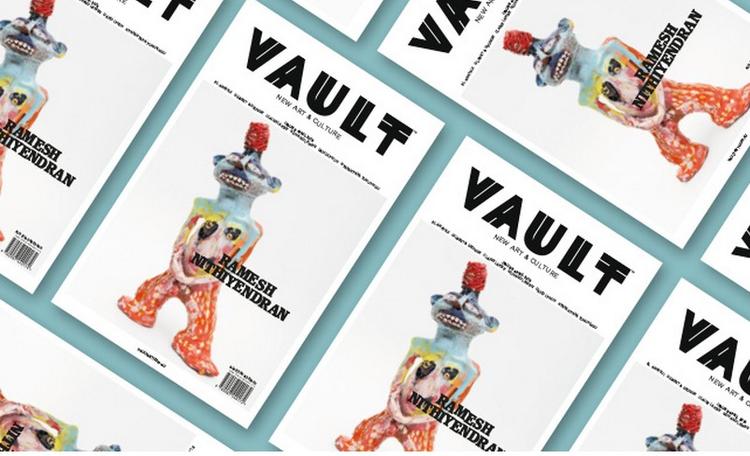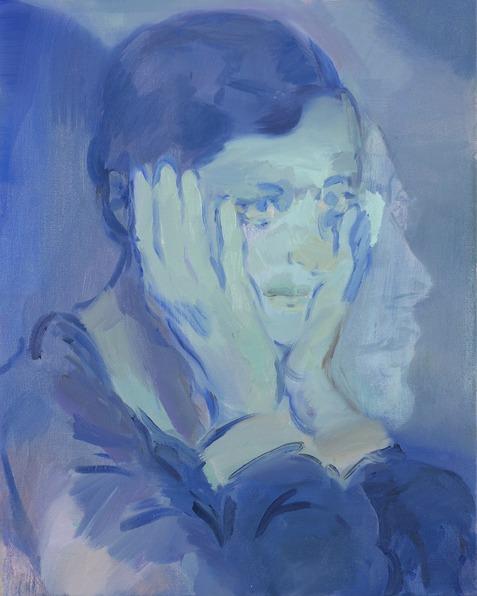First published in Vault magazine, April 2015.
To be a painter at the start of the 21st century is to find yourself in thrall to the technical overtures of those that have come before you but Kaye Donachie prefers the kinetic to the aesthetic. When the Glasgow-born artist talks about her process, it’s with an effervescence that befits someone whose paintings of ghostly heroines and twilight gatherings feel like they’ve been plucked from the viewer’s subconscious or, at the very least, magicked out of thin air.
“I’ve always been interested in paintings having energy and I like things that feel like they’ve been made in one breath,” Donachie tells me from her home in South London, transformed, courtesy of Skype, into one of her own smiling apparitions.
“When I think of Manet, Velazquez and Matisse, I’m drawn to their sense of immediacy and how their last touches give their paintings a certain feeling and flourish. There’s almost a detachment of the brushstrokes from the actual image and an openness to the way they painted, which isn’t about the surface of the painting but about the way something is described through the application of paint. It’s almost like erotic frisson.”
Donachie has spent the last decade proving the idea that frisson isn’t seen, but felt. In 2004’s Epiphany, she created a series of small-scale oil paintings in which long-haired youth frolic in settings that move between shadow and light. Featuring titles such as “Can’t find nothing I can put my heart and soul into” and “Every mornin’ our love is reborn”, verbal fragments lifted from poems and song lyrics, the paintings glow with the incandescence of a Ryan McGinley photograph but her sickly palette proves that hedonism is the flipside of despair. Walpurgis Night, a 2009 show at Berlin’s Peres Projects, recasts modernist rebels such as poet Emmy Hennings and psychologist Otto Gross – citizens of Monte Verita, an early utopian community in Switzerland that plays a recurring role in Donachie’s paintings – as fleeting keepers of a world outside time and place. Figures blur into backdrops to evoke the ways in which the blaze of progress is snuffed out by the lassitude of individual lives. And in Malady of Death, a 2013 solo show at Donachie’s London gallery Maureen Paley, ethereal green-and-blue faces are unmoored from the pages of a Marguerite Duras novella via painterly alchemy, swapping the logic of representation for the language of mood. It’s little surprise that Donachie’s work makes a regular appearance on Tumblr dashboards.
“I’m drawn to the idea that painting is more sensorial than any other medium, it has a physicality that I’m really attracted to and it’s almost about how atmospheric or visceral it can be,” says Donachie, who’s currently preparing for an upcoming British Council group survey featuring the work of the country’s contemporary painters. “My pieces are deeply romantic and almost rooted in absence. I’m fascinated with the world that exists between reality and dream and I’ve always loved Man Ray’s photography because his work has this strange ability to make things exist in darkness and light. You can access that world in a painting. That’s very interesting to me.”
Donachie, who was born in Glasgow and grew up in seaside East Anglia in the seventies, came to painting early. “My parents were quite liberal and I was always surrounded by art,” she recalls. “My mum always encouraged me to become an artist so I grew up thinking that was an actual path.” Although Donachie went on to study Fine Art at the University of Central England in Birmingham, it wasn’t until she started working towards her MA at London’s Royal College of Art in the late nineties – at a moment during which the Young British Artists’ dizzying output had fixed the world’s gaze on the London art scene – that her trajectory as a painter started taking shape. “At the Royal College of Art, I started to formalise what I wanted to achieve,” she says. “Peter Doig was teaching there, John Stezakar was teaching us theory. Other artists were reaching a point where they were becoming really ambitious and were taking off in different directions. They became real role models for me.” Was she swayed by the market’s love affair with the conceptual swagger symbolised by pieces such as Tracy Emin’s My Bed, which was nominated for the Turner Prize in 1999. “No, I never identified with the YBAs,” she grins. “But it was an intense period of time in British art that proved that you could show your work and be entrepreneurial within your own career. Towards the end of that YBA period, a lot of galleries attended MA shows to see what was coming out.” She met the gallerist Maureen Paley at her own MA show. Paley’s Bethnal Green gallery hosted her first solo exhibition a year later.
“Meeting Maureen Paley has been the defining point of my career,” says Donachie, whose paintings have appeared everywhere from the Prague Biennale and New York’s fabled Marianne Boesky gallery to the Dark Monarch: Magic and Modernity and British Art, a major group exhibition at Tate St. Ives. “I’ve worked with her a long time and she has always been very supportive of what I wanted in the work. Since I started with her, I’ve had great opportunities and she opened my eyes to the idea that you could curate your own exhibitions, rather than just put paintings up. I’ve evolved so much in terms of how the works in the space can relate to each other during a show. Having that gallery behind me has been a big thing.”
Donachie’s delight in the power of reference isn’t just limited to her own body of work, it also extends to a universe of ciphers, subtexts and signs. She says that the paintings she produced for The Malady of Death don’t dwell on the Marguerite Duras novella as much as they capture the book’s strange ability to show how one space can dissolve into another in the manner of an elliptical poem. “The references within my own work, from literature to filmmaking to photography, have always made me feel an affinity with different disciplines,” says Donachie, who maintains an archive of images and colour scraps that call up historical periods and moments in time. “I’ve always felt that although I paint, the research behind it is linked to so many other things that I almost feel like a filmmaker. You can have one singular image but that triggers off many. It’s all about how you visualise an idea.”
But Donachie, who spends early mornings mixing colours in her studio, doesn’t distinguish between the electricity of her process and that of her work. “I always work up to the deadline and am jealous of people who work at a more even pace,” she laughs. “But I make a lot of drawings and paintings and a lot of them get chucked. I’m looking for that particular moment of energy or emotion that allows me to produce things in one breath. But when I have too much time to think or fiddle with a painting, it just becomes stale for me. It’s much too dogmatic.”

